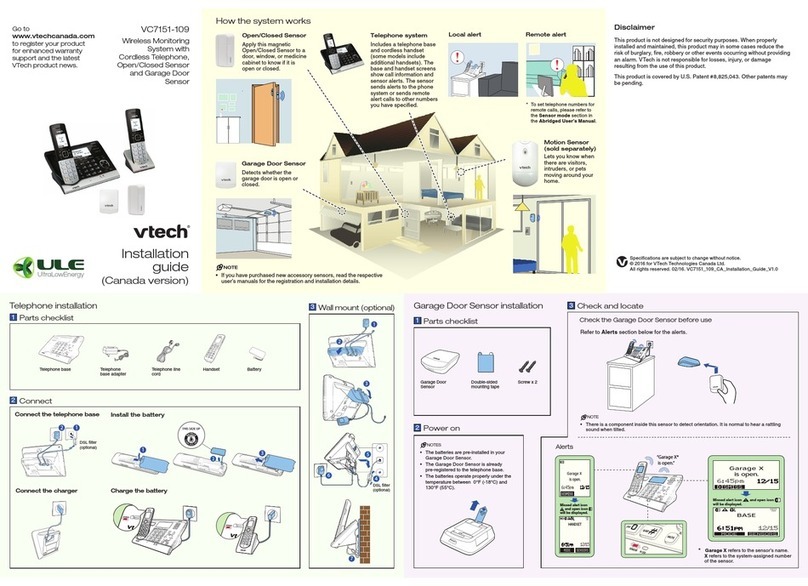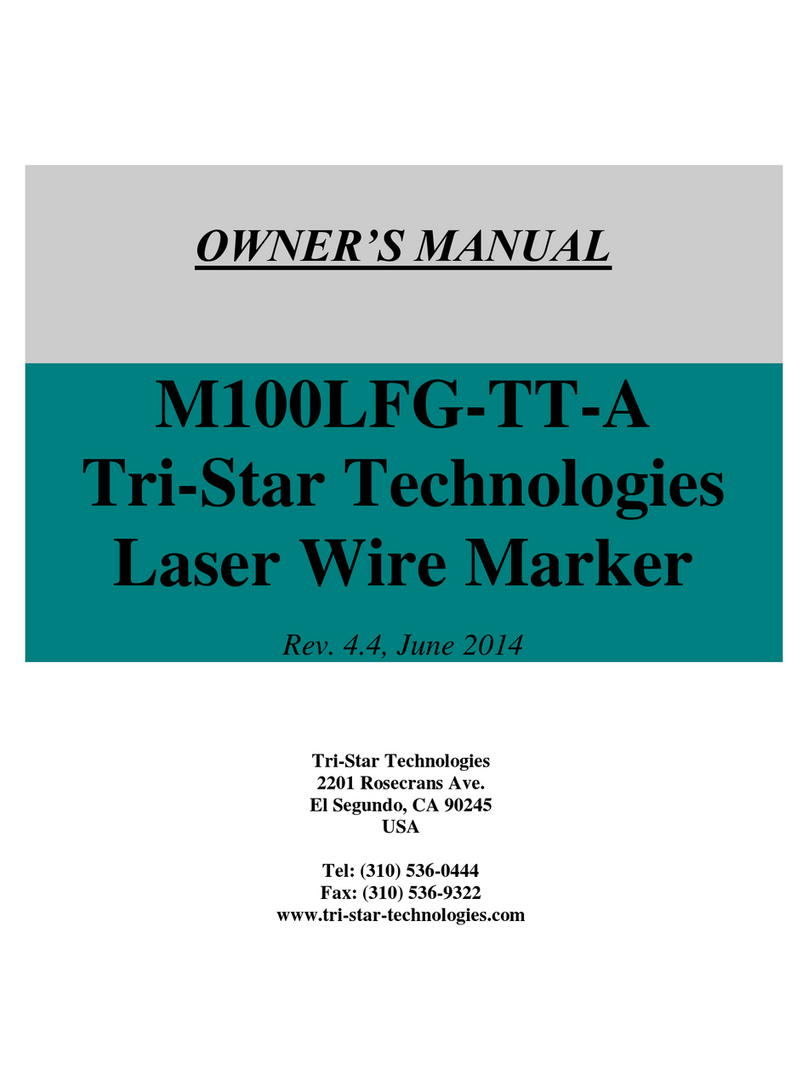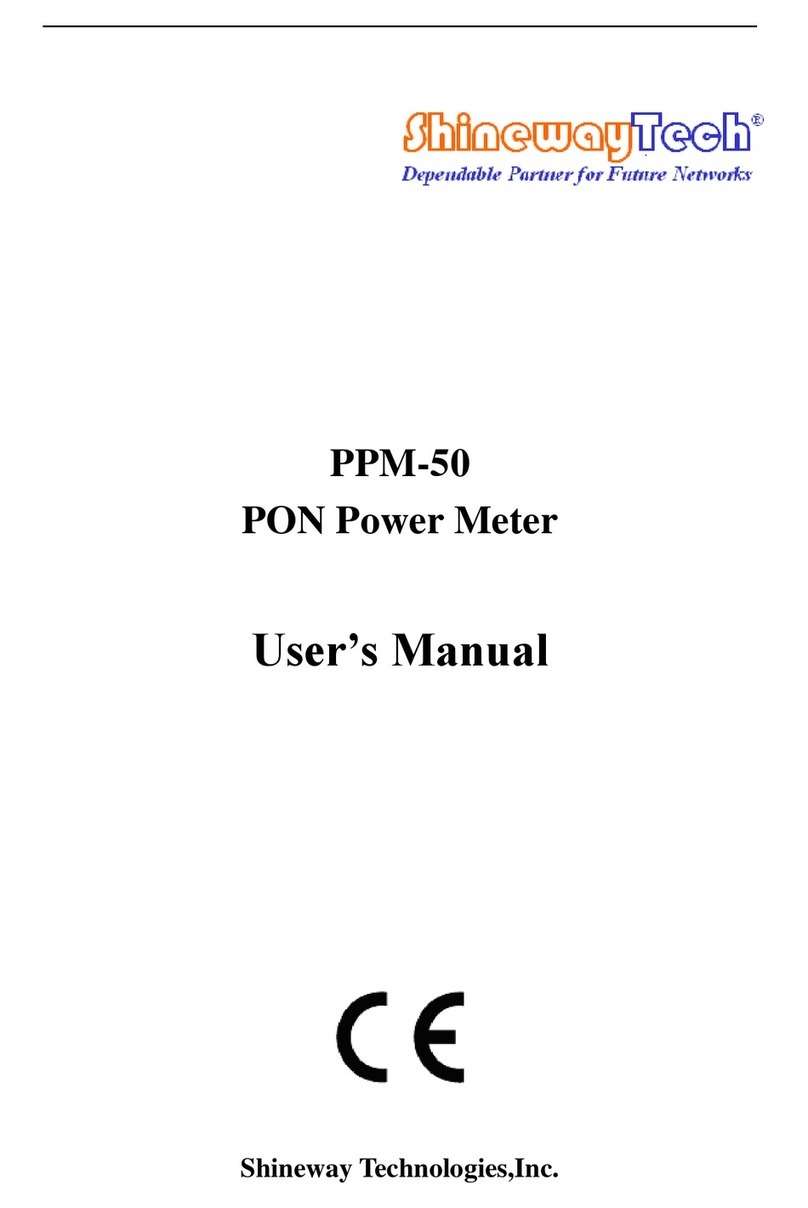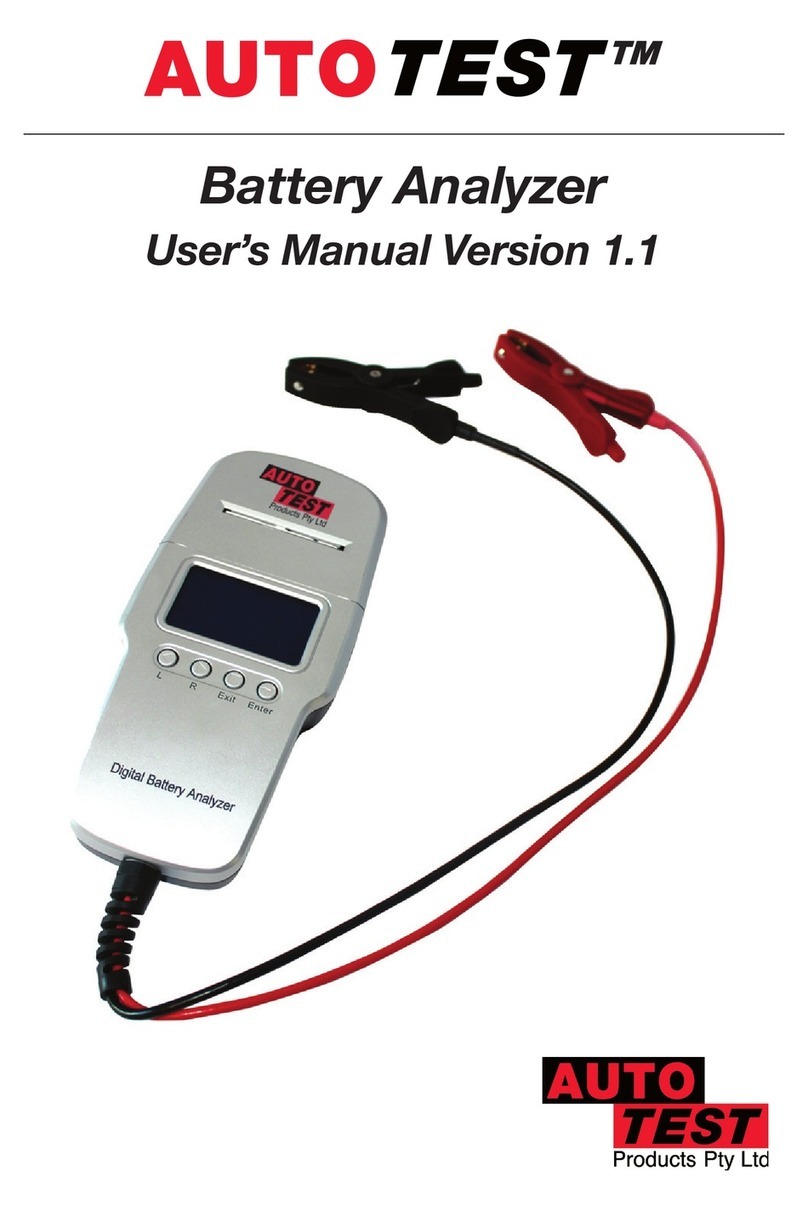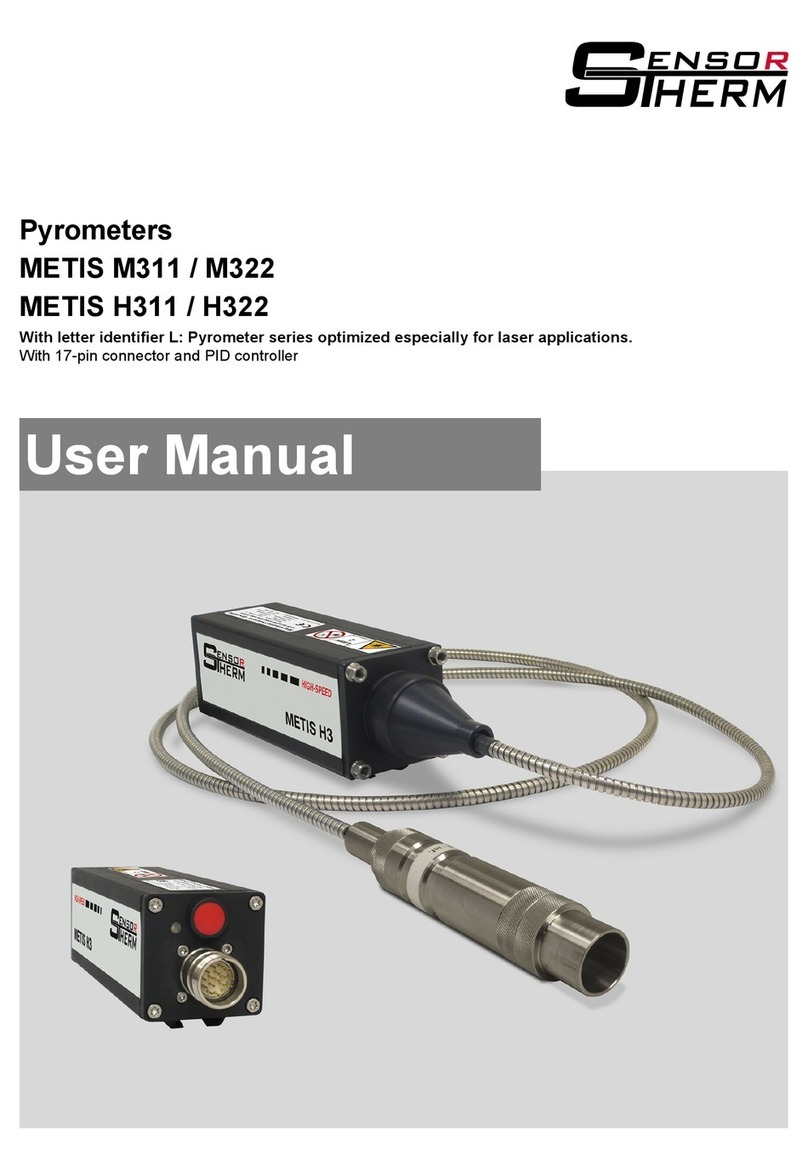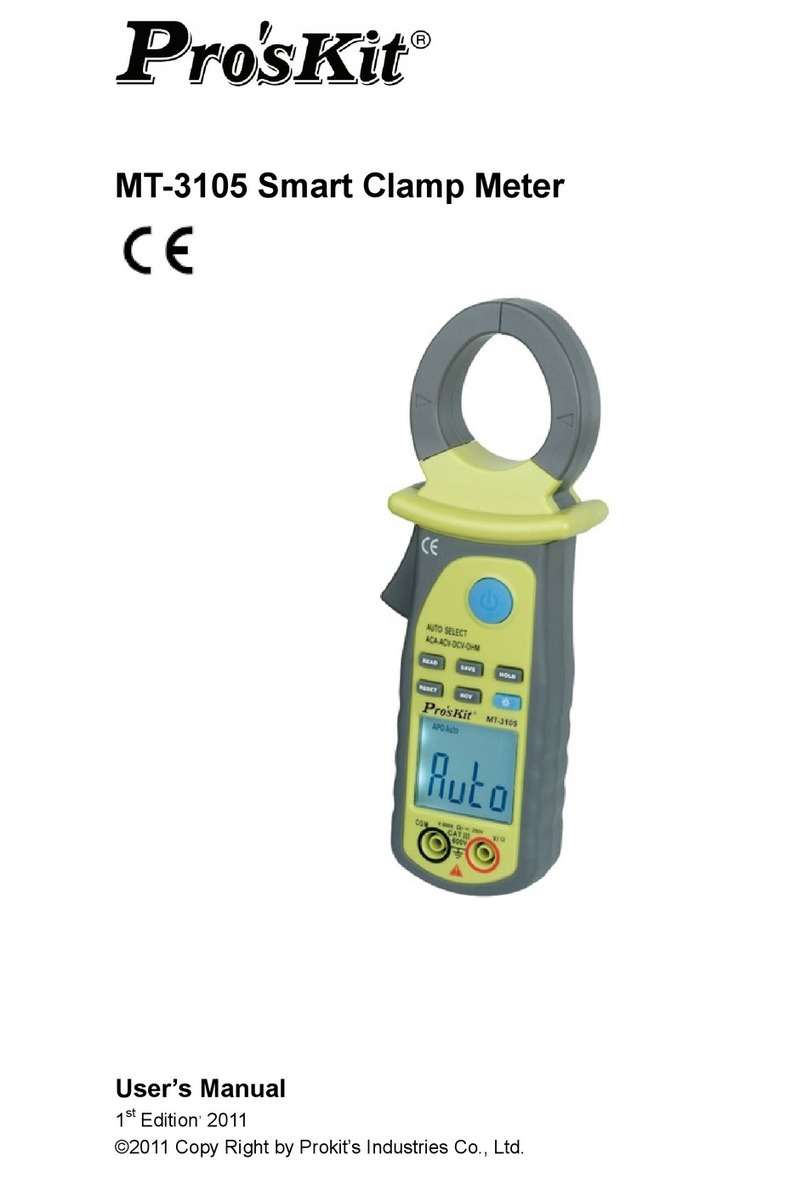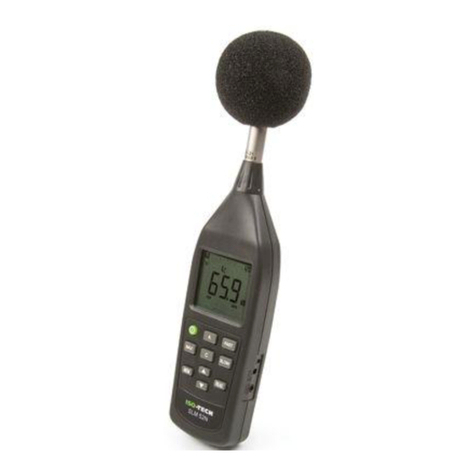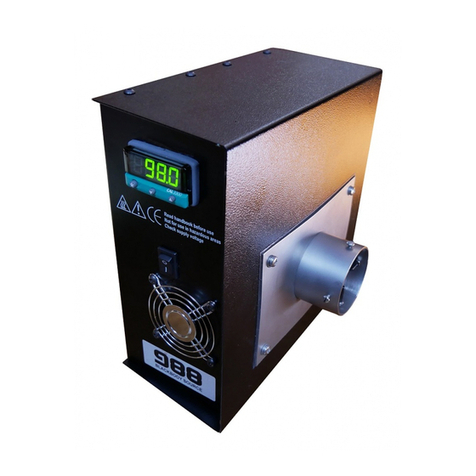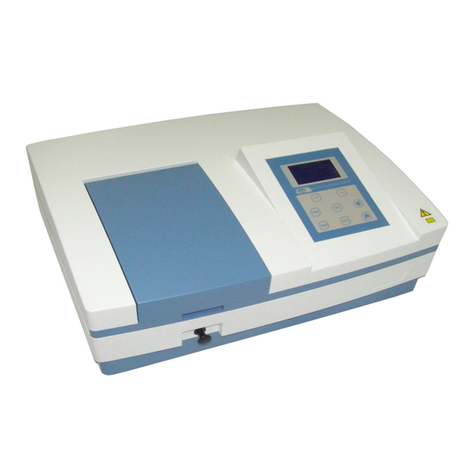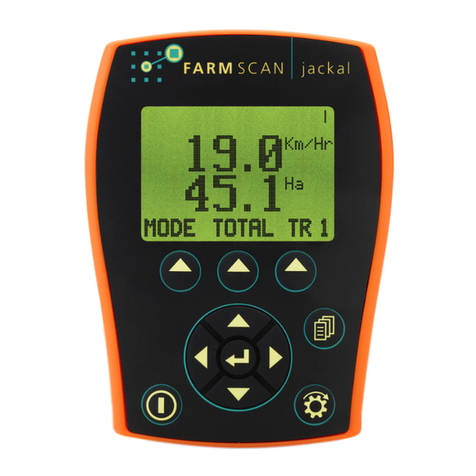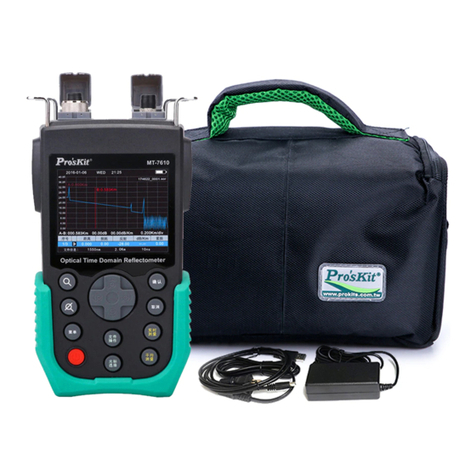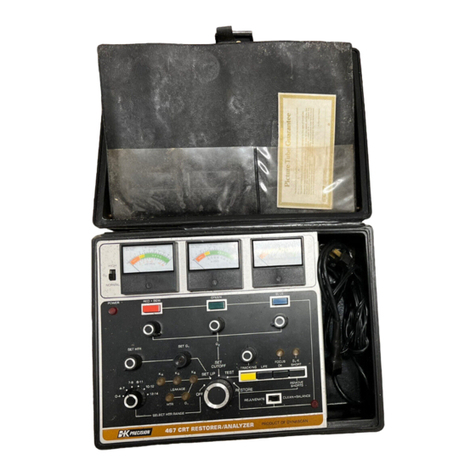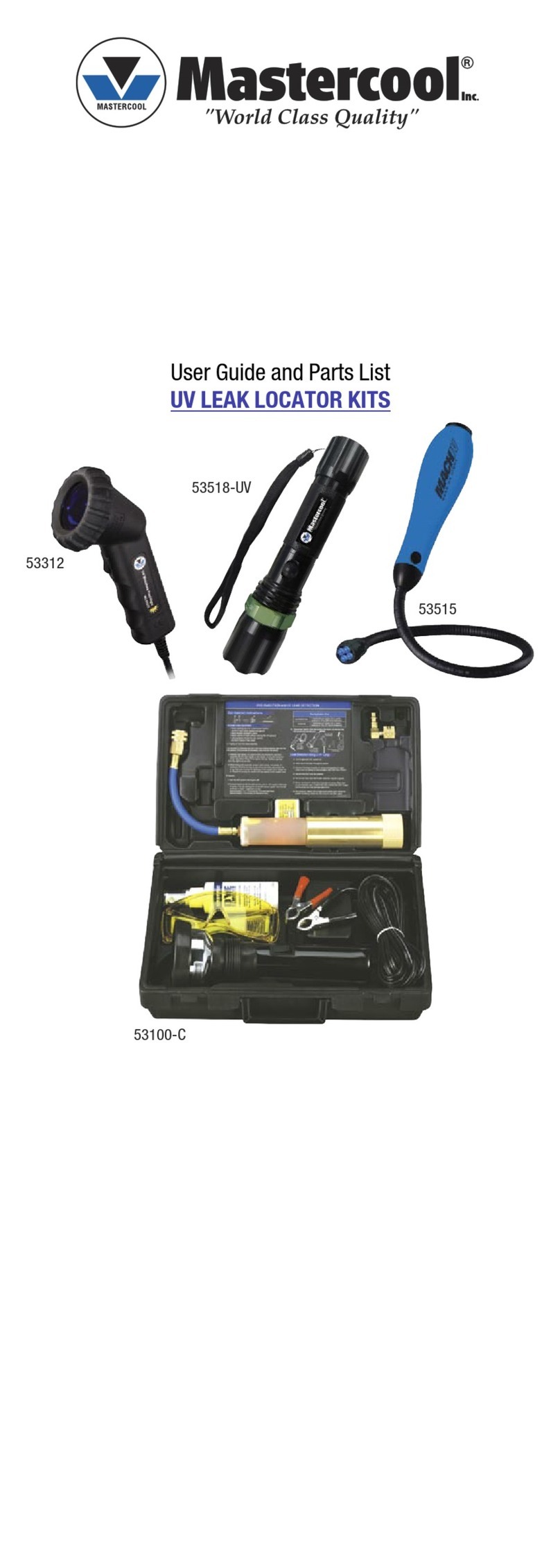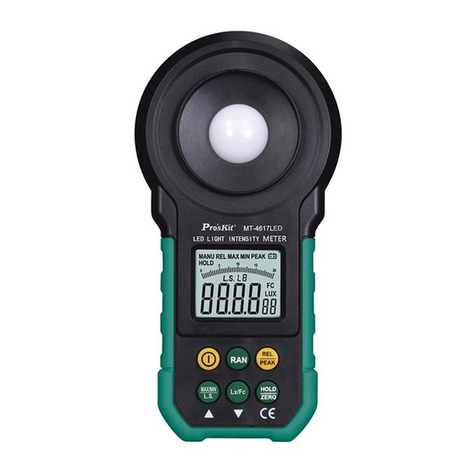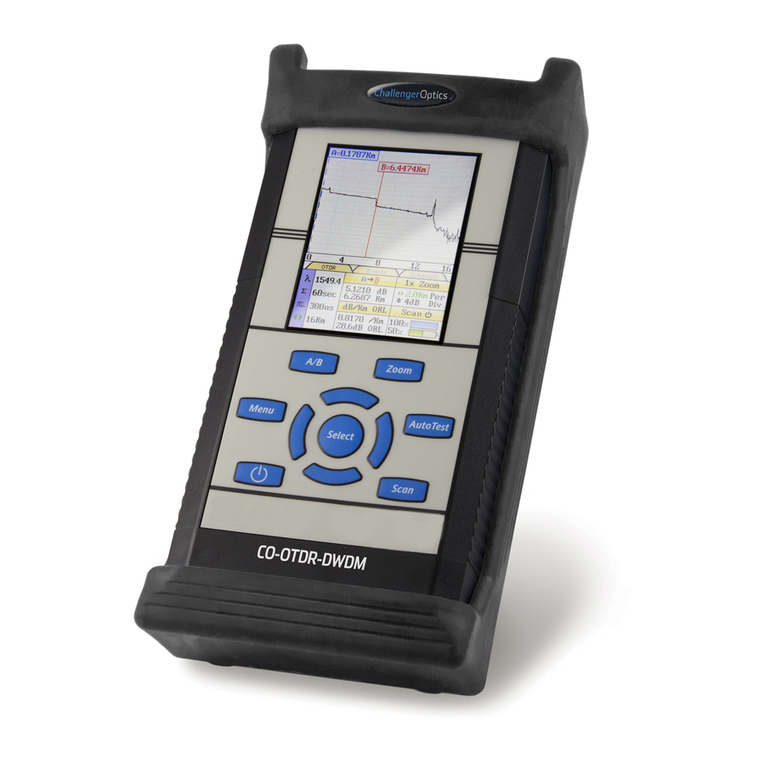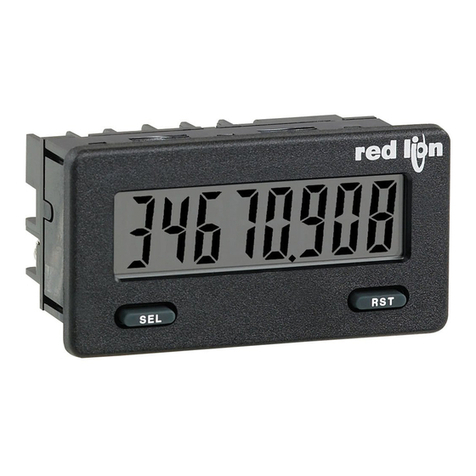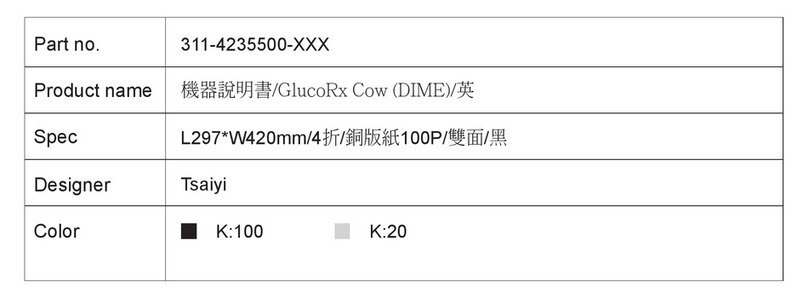Interscan Corporation 4000 Series User manual

120-00004 REV A 10/06/2011 4000 DIGITAL MANUAL PAGE 1
Instruction Manual
4000 Series Digital Portable Analyzer
www.GlobalTestSupply.com
Find Quality Products Online at: sales@GlobalTestSupply.com

120-00004 REV A 10/06/2011 4000 DIGITAL MANUAL PAGE 2
TABLE OF CONTENTS
SECTION TITLE PAGE
1.0 Equipment Description
Front Panel 4
Rear Panel 6
Right Side Panel 7
Internal components 8
2.0 Operating Instructions
Setting the Alarm 9
Zeroing the Instrument 10
Sampling 11
3.0 Calibration
Introduction 12
Sample Bag & Pressurized Cylinder Calibration 14
Calibration Procedure 15
4.0 General Maintenance
Battery Life 16
Battery Charging & Replacement 16
Water loss in Refillable Sensors 18
Long Term Storage 23
Post Storage Startup 23
5.0 Troubleshooting 24
6.0 Warranty 25
7.0 Return Authorization 26
8.0 Appendix
INTERFERING GAS DATA 27
SCRUBBER INFORMATION 31
www.GlobalTestSupply.com
Find Quality Products Online at: sales@GlobalTestSupply.com

120-00004 REV A 10/06/2011 4000 DIGITAL MANUAL PAGE 3
Introduction
Note: It is not necessary to calibrate the monitor when
received from the Interscan or an authorized distributor.
All Interscan monitors are calibrated at the factory prior to
shipment.
The Interscan 4000 Digital series operates on the principle of
pulling a sample (Sample draw) through a sensor. The
Electrochemical sensor is manufactured by Interscan.
Electrochemical means that it produces an electrical current
proportional to the level of gas passing through. The large size of
the Interscan sensors results in larger reactive surface area which
yields greater sensitivity.
Equipment Description
1.0 Front Panel
(fig. 1)
www.GlobalTestSupply.com
Find Quality Products Online at: sales@GlobalTestSupply.com

120-00004 REV A 10/6/2011 4000 DIGITAL MANUAL PAGE 4
Designation Function
LCD Display: Indicates gas level when function switch is in
ZERO or SAMPLE, and battery level when
on BAT. TEST A or B.
ALARM Light: LED. Flashes ON/OFF when alarm set
point is exceeded.
ALARM SET: 25-Turn potentiometer with a screwdriver
adjustment. Sets the alarm trip point at the
desired gas level. (low alarm set must be
greater than 5% of the full scale).
SPAN/CAL: 25-Turn potentiometer with a screwdriver
adjustment. Sets display to correspond to the
concentration of the calibration gas used for
calibrating the instrument or to the level
specified on ECS certificate. Note: The ECS
certificate is only provided if you
purchased the ECS program.
FUNCTION SWITCH: Rotary switch as follows:
OFF: Analyzer power is OFF.
ZERO: Analyzer power is ON (pump is OFF).
SAMPLE: Analyzer power and pump are on. Also in
this position (depending on the gas model)
the analyzer is zeroed. Sample
measurements and calibration are
accomplished in the sample mode.
BAT. TEST A: Indicates state of charge of the Nickel-
Cadmium (NiCd) batteries on the LCD
Display. These batteries power the pump &
alarm. Recharge if the LCD Display level
falls to or below 100 (ignore decimal point).
BAT. TEST B: Indicates state of charge of the “C” size
alkaline batteries on the LCD Display. These
www.GlobalTestSupply.com
Find Quality Products Online at: sales@GlobalTestSupply.com

120-00004 REV A 10/6/2011 4000 DIGITAL MANUAL PAGE 5
batteries power the main circuitry and are
NOT re-chargeable. Replace if the LCD
Display level falls to or below 100 (ignore
decimal point). You must allow 24 hours to
stabilize prior to use if the batteries are
replaced.
ZERO: 10-Turn Potentiometer. Allows the meter to
be adjusted to zero, by compensating for any
background signal.
1.1 Rear Panel
(fig. 2)
Designation Function
INLET: ¼” O.D. Quick connect or compression gas
fitting.
OUTLET: ¼” O.D. Quick connect or compression gas
fitting.
www.GlobalTestSupply.com
Find Quality Products Online at: sales@GlobalTestSupply.com

120-00004 REV A 10/6/2011 4000 DIGITAL MANUAL PAGE 6
RECORDER OUTPUT: ¼” phone jack for Analog recorder output
connection. Typically 0-100mV. Tip –
positive, Ring – ground.
CHARGER INPUT: 3.5mm phone jack for 9V DC, 100mA
charger input. Tip – positive, Ring – ground.
SENSOR SCREWS: Used to hold Sensor or Sensor base in
place.
1.2 Right Side Panel
(fig. 3)
AUDIBLE ALARM: Piezoelectric Horn, sounds when alarm set
point is exceeded.
www.GlobalTestSupply.com
Find Quality Products Online at: sales@GlobalTestSupply.com

120-00004 REV A 10/6/2011 4000 DIGITAL MANUAL PAGE 7
The above (fig 3) indicated two #1 Phillips-head screws located on the right
side panel. Removing these screws allows access to the internal
components. Do not remove any other screws.
1.3 Internal Components
(fig. 4)
www.GlobalTestSupply.com
Find Quality Products Online at: sales@GlobalTestSupply.com

120-00004 REV A 10/6/2011 4000 DIGITAL MANUAL PAGE 8
Operating Instructions
For overseas shipment, analyzers are shipped with the 15-Pin D
connector DISCONNECTED from the circuit board. This is to
preserve the battery life during shipment. To re-connect the wire
bundle, simply open the analyzer by removing the 2 screws
located on the right side panel. They are located about 1 inch from
the top and 1 inch from the bottom, on the door. (fig. 2 pg. 6) Re-
connect the 15-pin D connector and allow 24 hour stabilization
prior to use.
2.0 Setting the Alarm
Normally, the alarm is set at the Factory at 50% of full scale. The
alarm can be reset to any desired level by following the procedure
below. Minimum alarm level must be greater than 5% of the full
scale measuring range.
Set FUNCTION switch to ZERO. Using the ZERO control,
advance the LCD display to the desired alarm set point. Some
analyzers require the use of span tool (provided). Adjust the
ALARM SET (fig. 1 pg. 4) control until the alarm sounds. Adjust
the ZERO control slightly counterclockwise until the alarm is silent.
To confirm setting slowly adjust the ZERO control clockwise until
the alarm sounds. Re-adjust the ALARM SET control if
necessary. Adjust the ZERO control for a reading of “0” on the
display.
www.GlobalTestSupply.com
Find Quality Products Online at: sales@GlobalTestSupply.com

120-00004 REV A 10/6/2011 4000 DIGITAL MANUAL PAGE 9
2.1 Zeroing the Analyzer
The Analyzer must always be zeroed, prior to use.
Zero adjustments must be made in the SAMPLE mode, i.e. with
the pump on, in air free of interfering gases. If necessary, use zero
air or a C-12 filter (provided) to zero in the sampling area. When
using C-12 zero filter, connect externally to gas inlet. Allow reading
to stabilize, before making final zero adjustment, (stabilization can
take approximately 20 minutes). The C-12 filter must be removed
after zeroing the analyzer.
www.GlobalTestSupply.com
Find Quality Products Online at: sales@GlobalTestSupply.com

120-00004 REV A 10/6/2011 4000 DIGITAL MANUAL PAGE 10
2.2 Sampling
Analyzer must be zeroed prior to sampling (section 2.1).
Set the FUNCTION switch to SAMPLE to activate the pump. If the
INLET or OUTLET is blocked, the pump may stall. Note: Running
the Analyzer with blocked INLET or OUTLET may lead to the
sensor leaking caustic electrolyte leading to analyzer
damage. Power analyzer off, and clear the blockage. To reset
the pump, set the FUNCTION switch to ZERO momentarily and
then switch again to SAMPLE.
Nominal sample rate in MOST analyzers is approximately 1.0,
0.2 liter per minute. NOTE: For hydrazine analyzers with the
measuring range of 0-100ppb the sample flow rate is 2.2 0.2
liters per minute. The Average sample run time, starting with fully
charged “C” NiCd batteries, is 12 hours. If the BATTERY TEST
“A” indication is down to 100 on the LCD display, the flow rate
may have started to decrease. This is usually not a problem
unless very precise readings are required.
Sampling from high pressure may only be achieved by using the
method indicated in (fig. 5).
Note: The sample to the Interscan Analyzer must be drawn
perpendicular to the Sample flow stream.
Pressurized
Sample
Minimum flow
rate 1.4 liters per
minute
To Interscan
Analyzer inlet
To Ambient pressure or
Vacuum not to exceed 3
inches of water.
(fig. 5)
www.GlobalTestSupply.com
Find Quality Products Online at: sales@GlobalTestSupply.com

120-00004 REV A 10/6/2011 4000 DIGITAL MANUAL PAGE 11
Calibration
3.0 Introduction
All analyzers are factory calibrated prior to shipment.
There is no easy answer as to how often a monitor should be
calibrated. This is strictly a function of the application (gas
concentration and frequency of exposure to target gas). The
purpose for calibration is to compensate for any possible decrease
in sensor sensitivity. The primary cause of sensitivity decrease is
excessive loss of water by evaporation. A secondary cause may
be by contamination from unknown sources. H2S sensors show
an additional decrease in sensitivity due to internal sulfur
formation, the rate of which depends on the gas concentration.
3.1 INTERSCAN’S Electronic Calibration Service
The factory recommended procedure for calibrating all
INTERSCAN analyzers, involves the use of certified calibration
gas or a permeation device. Besides being essential for
calibration, having a known certified gas standard on hand allows
the user to test the analyzer at any time to determine that it “really
works”.
However, there will be times and circumstances in which
calibration using calibration gas or permeation devices is
inconvenient and costly. For this reason, INTERSCAN has
developed our alternative sensor revolving/certification program,
Electronic Calibration Service (ECS).
A certified spare sensor is kept at the customer’s site to be
installed into the analyzer, (after following the 7 steps on the ECS
certification) while the presently used sensor is sent back to the
factory for re-certification. The ECS certification, details zero and
span/cal adjustments that are to be made on the analyzer, to
match or coincide with the specified, newly certified sensor.
www.GlobalTestSupply.com
Find Quality Products Online at: sales@GlobalTestSupply.com

120-00004 REV A 10/6/2011 4000 DIGITAL MANUAL PAGE 12
As indicated on the certification sheet, the ECS program verifies
sensor sensitivity only. It does not certify the analyzer as a whole.
Most importantly, the ECS program is not a substitute for basic
analyzer maintenance, nor does it check for malfunction of the
analyzer components.
www.GlobalTestSupply.com
Find Quality Products Online at: sales@GlobalTestSupply.com

120-00004 REV A 10/6/2011 4000 DIGITAL MANUAL PAGE 13
3.2 Sample Bag Calibration & Pressurized Cylinder
Calibration
Whatever the source of calibration gas, the recommended method
is to collect the gas in the proper sample bag, which is then
attached to the analyzer INLET. The calibration gas is drawn from
the proper sample bag through the sensor. An exception to the
use of a sample bag is for those gases, which are reactive with, or
chemisorbed by the bag itself (e.g. Chlorine, Hydrazine). Teflon®
or Tedlar® bags are suitable for H2S, SO2, NO and NO2. Several
bag materials are suitable for CO. Contact the Factory for
recommendations.
The sample bag method is the factory-recommended method for
calibration. Since an internal pump is used, the same flow rate
conditions during the sample and the calibrate modes are
assured, eliminating errors due to flow rate differences. For most
applications, using a bag is the simplest procedure.
A regulated pressurized certified cylinder fitted with a tee-manifold
(fig. 6) and unrestricted vent is a good procedure in place of the
sample bag, as long as the flow rate of the gas exceeds that of the
sample pump.
Pressurized
Ceritified gas
Minimum flow
rate 1.4 liters per
minute
To Interscan
Analyzer inlet
To Ambient pressure or
Vacuum not to exceed 3
inches of water.
(fig. 6)
www.GlobalTestSupply.com
Find Quality Products Online at: sales@GlobalTestSupply.com

120-00004 REV A 10/6/2011 4000 DIGITAL MANUAL PAGE 14
3.3 Calibration Procedure
Analyzer must be zeroed prior to calibration (sec 2.1).
1. For all gases, except Chlorine or other chemisorbable types, fill the 5
liter sample bag with calibration gas, and attach it to the external inlet
fitting. This is best done by attaching a short length (2 inch) of 5/16 inch
(7.9 mm) O.D. flexible tubing to the sample bag nipple, then attaching
the tubing to a 2 inch (51 mm) length of ¼ inch (6.4 mm) O.D. rigid
tubing contained within a gas fitting nut securely fastened to the inlet
fitting.
2. Set the FUNCTION switch to SAMPLE.
3. Allow 2 to 3 minutes for the reading to stabilize, and by using the
SPAN/CAL control, set the display to match the calibration gas
concentration being used.
4. Remove the sample bag from the analyzer and allow the display to
stabilize.
5. The analyzer is now calibrated and set up for operation.
www.GlobalTestSupply.com
Find Quality Products Online at: sales@GlobalTestSupply.com

120-00004 REV A 10/6/2011 4000 DIGITAL MANUAL PAGE 15
General Maintenance
4.0 Battery Life
Because of current requirements of the circuitry, “C” Size Alkaline
battery life is approximately 4 weeks, whether the unit is operating
or not. Note: Batteries vary in capacity by manufacturer and
may provide more battery life. Analyzer malfunction, as a
result of low battery, will be evident as either inability to zero the
monitor or clipping of the display at a fixed reading below full
scale.
Nickel-cadmium battery life is indeterminate. It is somewhat
dependent upon how well the charge level is maintained.
4.1 Battery Charging and Replacement
All models of the 4000 Series analyzers use two “C” size alkaline
batteries. These are located on the hinged door, right side (fig. 4
pg. 7). Polarity is marked on the door over the battery holder.
If alkaline batteries are replaced before the Battery Test “B”
indicates a low battery condition, a few minutes warm
up/stabilization is needed before using the analyzer. If alkaline
batteries are low or dead, the analyzer should be allowed to sit for
12 to 24 hours after battery replacement. The FUNCTION switch
should be set to OFF during this time. This is to allow the sensor
time to stabilize again.
The rechargeable batteries are ½ “C” size NiCd and are rated at
0.80 ampere hours. They are mounted on the hinged door, left
side (fig. 4 pg. 7). Polarity is marked on the door, over the battery
holder. All models use four ½ cell “C” size NiCd batteries.
Condition is shown in the BATTERY TEST “A”, FUNCTION switch
position. The NiCd battery voltage changes quite rapidly as it
approaches the recharge point, which makes accurate display
www.GlobalTestSupply.com
Find Quality Products Online at: sales@GlobalTestSupply.com

120-00004 REV A 10/6/2011 4000 DIGITAL MANUAL PAGE 16
indication difficult. It is recommended that the batteries be
recharged if the reading in BATTERY TEST “A” is at 100 (ignoring
the decimal place). Allowing the reading to drop below 100 is not
recommended. Note: NiCd batteries can develop cell
memory. Cell memory is caused by running the analyzer on
battery power for a short period of time REPEATEDLY i.e:
Running the analyzer for 20 minutes and then recharge. If
this occurs repeatedly, the NiCd battery life will only retain a
20 minute charge memory.
The charger is an external 9V DC, 100mA transformer and is
connected to the rear of the unit prior to charging. The tip is
positive and the ring ground. The FUNCTION switch should be
set to OFF or ZERO when charging. The recommended charge
time is 16 hours.
4.2 Water loss in Refillable sensors.
(fig. 7)
All sensors provided with a fill port require that the electrolyte
matrix is maintained in a near-saturated condition in order to
provide optimum performance. This is achieved by injecting
www.GlobalTestSupply.com
Find Quality Products Online at: sales@GlobalTestSupply.com

120-00004 REV A 10/6/2011 4000 DIGITAL MANUAL PAGE 17
distilled or deionized water into the sensor via the red plug, using
the plastic syringe (provided).
Refer to (fig. 7 pg. 16). Refillable sensors are identified by the red
fill plug in the side of the sensor. The fill plug location may vary
from (fig. 7 pg. 16). There are two types of refillable sensors. The
S-type is a shorter sensor of slightly over 2 1/2 inches ( 64 mm) in
height; the P-type is almost 4 inches (104 mm) in height. “P” and
“S” type sensors connect to the analyzer by different connection
methods.
For portable survey monitors, the sensor should be removed and
weighed every 1 to 2 months, depending upon usage. Again it is
advisable not to exceed a maximum weight loss of more than 25
grams.
Sensor weight is restored be removing the sensor from the
analyzer and comparing the current weight of the sensor with its
original weight (in grams). Sensor weight is indicated on a label
located on the side of the sensor.
There are three types of gas fittings used depending on the age of
the original sensor and the gas being measured.
(fig. 8)
Male elbow ¼ O.D. tube compression fitting
This is a compression fitting comprised of the body, nut and two
ferrules (fig. 8). Disconnect by loosening the nut until the tubing
can be pulled away from the body. To re-attach insert the tubing
and tighten the nut. Do NOT over tighten the nut as this will
damage the nut and fitting
www.GlobalTestSupply.com
Find Quality Products Online at: sales@GlobalTestSupply.com

120-00004 REV A 10/6/2011 4000 DIGITAL MANUAL PAGE 18
(fig. 9)
Quick connect male elbow
This is a quick connect system comprised of the body, o-ring and
ferrule (fig. 9). Disconnect by pushing on the ring where the tubing
enters the fitting and gently pulling on the tubing. Re-attach by
inserting the tubing all the way in and then gently pull backward.
(fig. 10)
Barbed male elbow
The fitting uses a barbed connector system (fig. 10). Disconnect
by pulling on the tubing. Re-attach by pushing the tubing onto the
fitting until firmly seated.
www.GlobalTestSupply.com
Find Quality Products Online at: sales@GlobalTestSupply.com

120-00004 REV A 10/6/2011 4000 DIGITAL MANUAL PAGE 19
Fig. 11
For P-type sensors refer to (fig. 11). Disconnect the 2 electrical
connections to the sensor. Disconnect the tubing from each gas
fitting. Loosen the screw indicated as “A”. Loosen the clamp screw
“B” until the sensor can be removed from clamp.
NOTE: DO NOT REMOVE ANYTHING ELSE!!!!!!
Restore the sensor to within 5 grams original sensor weight by
injecting an equivalent cc of distilled or deionized water (10g.
weight loss means add 10cc water). DO NOT OVERFILL. If
sensor will not take on any more liquid (liquid starts coming out the
fill port) do not attempt to add additional distilled water.
Note: Weight loss of excess of 30 grams may prevent the
restoration of the weight to within 5 grams of the original
weight. DO NOT OVERFILL. After weighing and refilling replace
the sensor in the analyzer, tighten screw “B” taking care only to
make it tight so as to secure the sensor. Then tighten screw “A”,
do not over tighten. Assure that all electrical and pneumatic
fittings are secure. The sensor should be allowed to stabilize for
several hours with power off, (up to 24 hours).
www.GlobalTestSupply.com
Find Quality Products Online at: sales@GlobalTestSupply.com

120-00004 REV A 10/6/2011 4000 DIGITAL MANUAL PAGE 20
(fig. 12)
For S-type sensors refer to (fig. 12). Disconnect the two electrical
connections to the sensor. Disconnect the tubing from each gas
fitting. Remove the two Sensor Screws.
NOTE: DO NOT REMOVE ANYTHING ELSE!!
www.GlobalTestSupply.com
Find Quality Products Online at: sales@GlobalTestSupply.com
Other manuals for 4000 Series
2
Table of contents
Other Interscan Corporation Measuring Instrument manuals
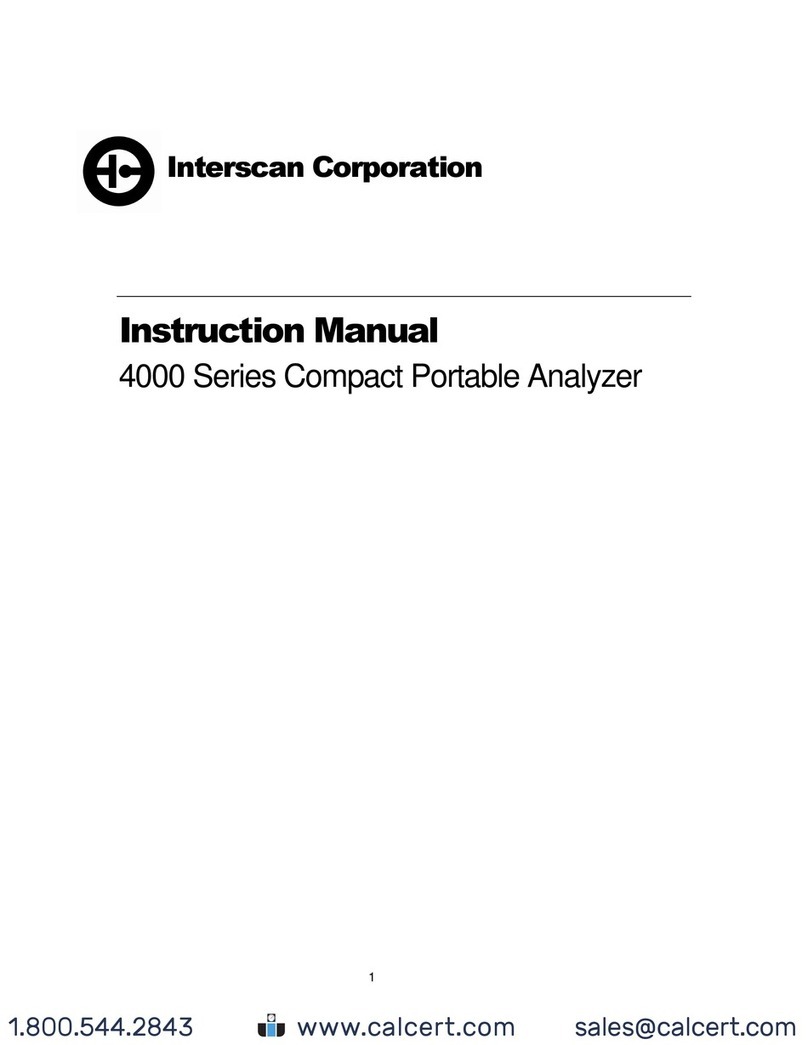
Interscan Corporation
Interscan Corporation 4000 Series User manual
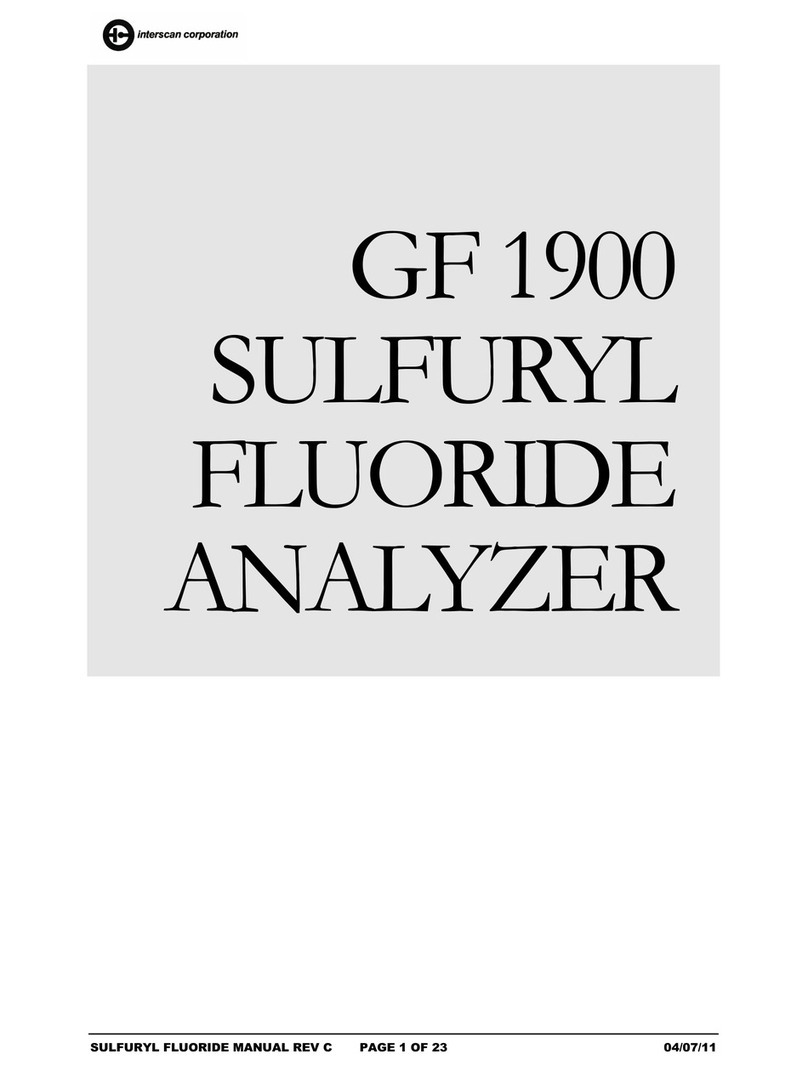
Interscan Corporation
Interscan Corporation GF1900 User manual
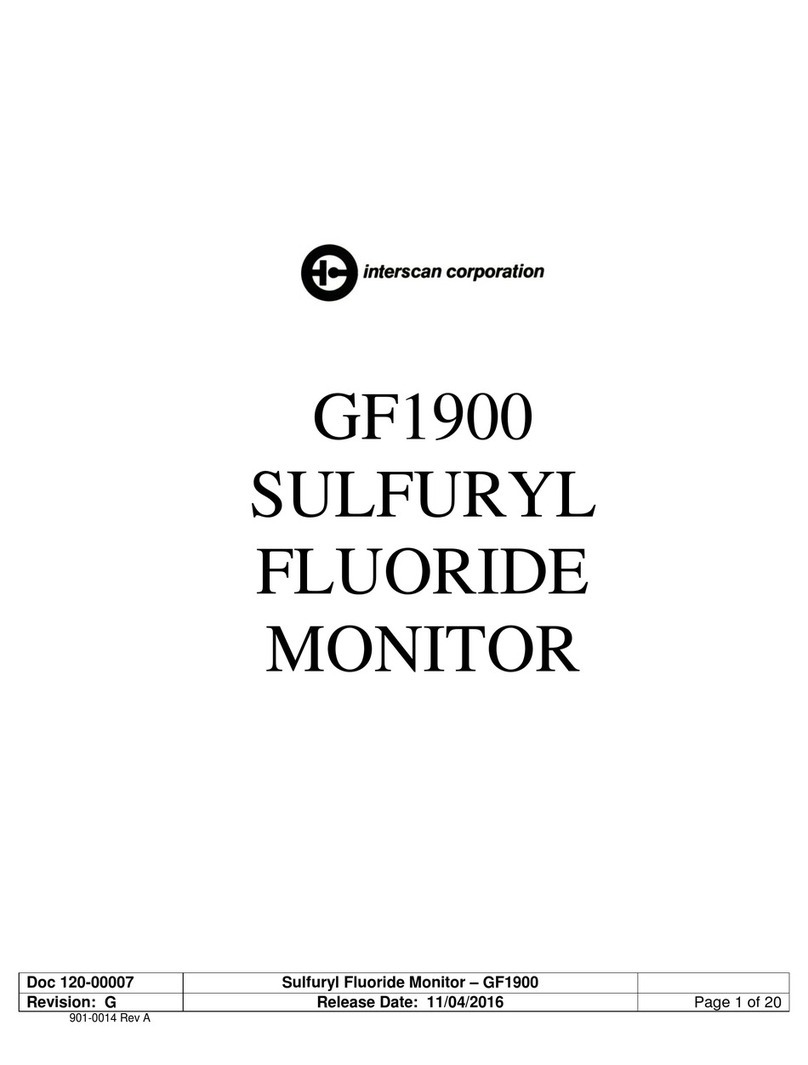
Interscan Corporation
Interscan Corporation GF1900 User manual

Interscan Corporation
Interscan Corporation 4000 Series User manual
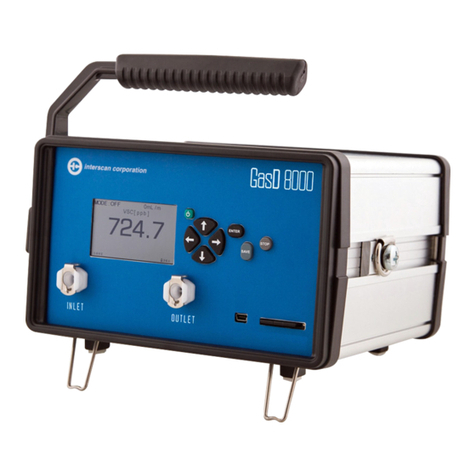
Interscan Corporation
Interscan Corporation GasD 8000 Series User manual
